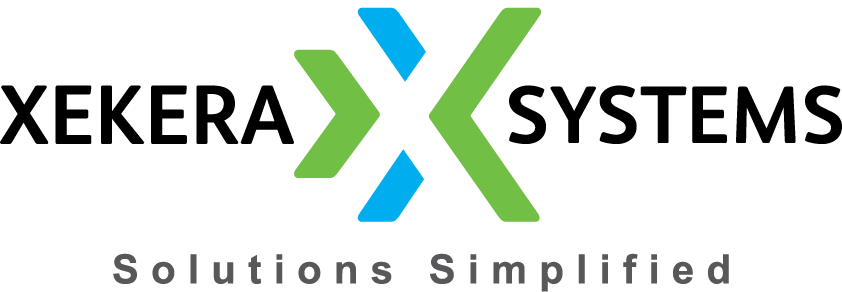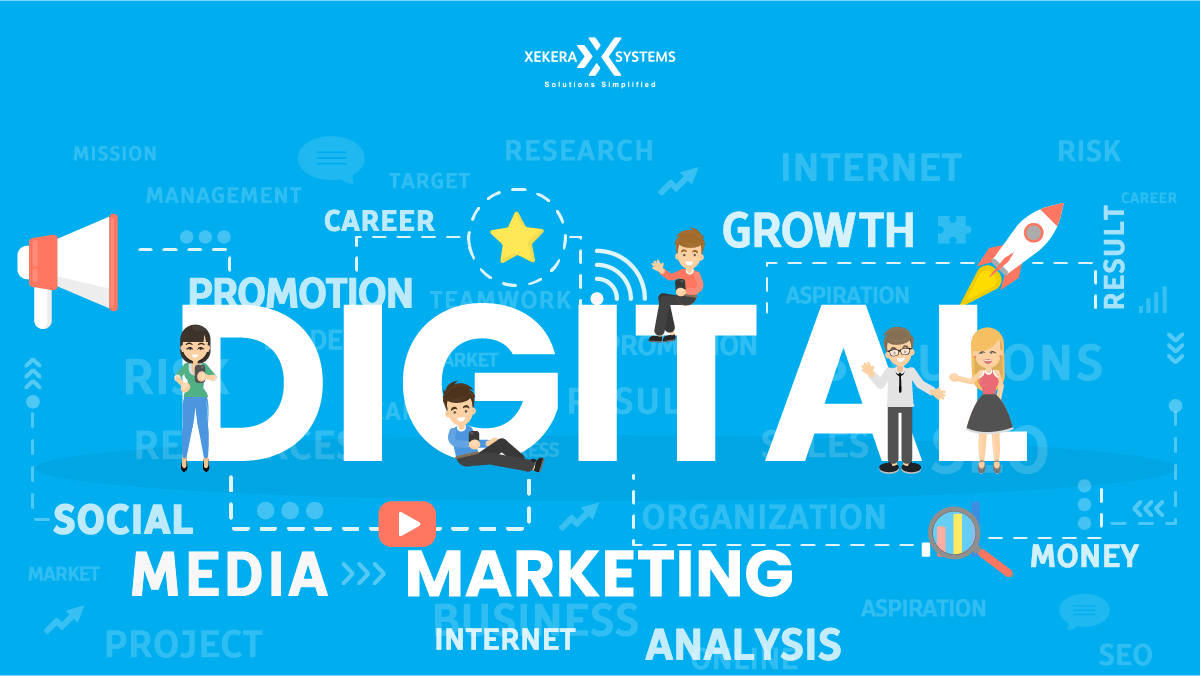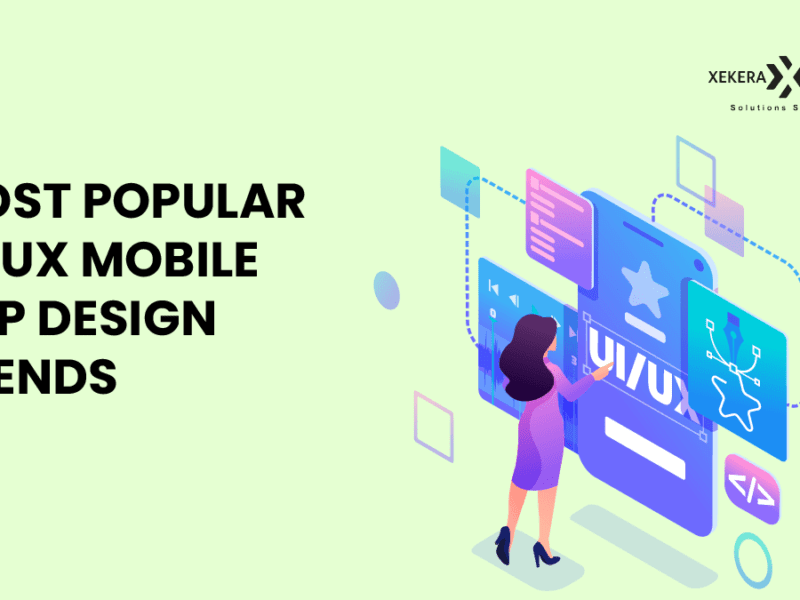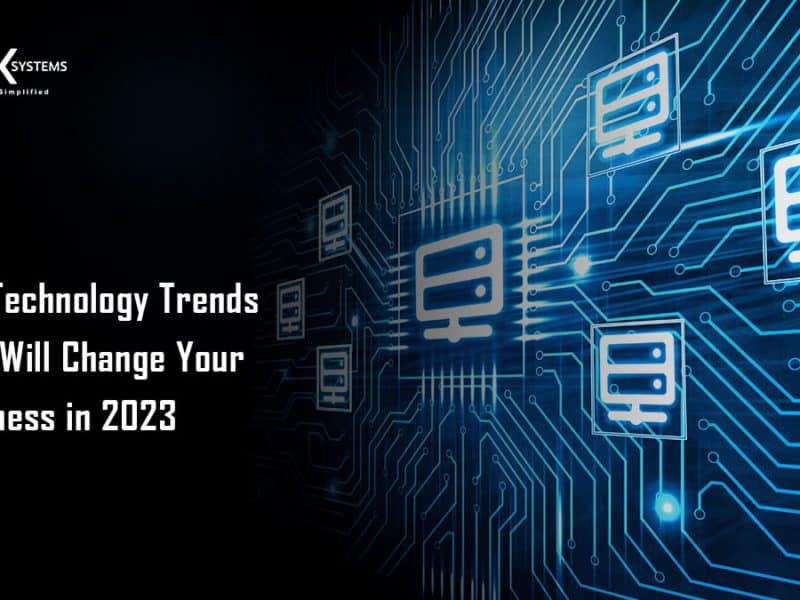Would you believe it if I told you that today’s Internet accessibility continues to increase the number of people accessing the Internet every day?
Yes. In fact, research show that an adult’s “always-on” Internet usage has increased by 5% over the past three years. It is often said that the way we shop and shop has changed dramatically. As a result, his offline his marketing is not as effective as it used to be.
Marketing is about connecting with your audience in the right place at the right time. Today, that means they need to meet where they already spend their time: the internet. In other words, any form of marketing that exists online.
What is digital marketing?
Digital marketing, also known as online marketing, refers to all marketing techniques that take place over the Internet. Businesses use digital channels such as search engines, social media, email, and other websites to connect with current and potential customers. This includes communication by text or multimedia messages.
A seasoned inbound marketer might say that inbound marketing and digital marketing are virtually the same thing, but there are some nuances. By speaking with marketers and business her owners in the US, UK, Asia, Australia and New Zealand, we have learned a lot about how these small differences are observed around the world.
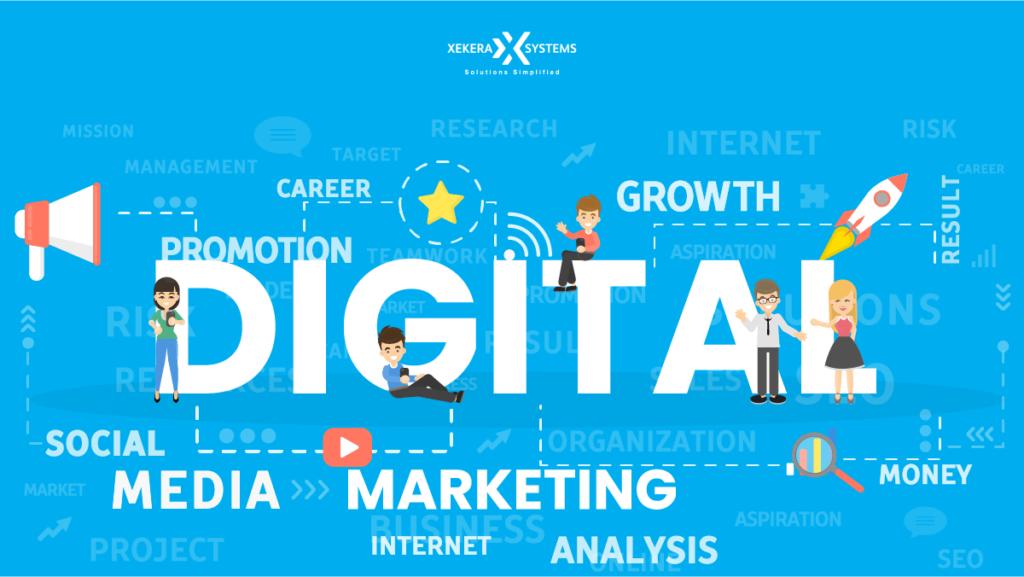
How do companies define digital marketing?
At this stage, digital marketing is critical to business and brand awareness. Every other brand seems to have a website. If not, at least have a social media presence and digital advertising strategy
Digital content and digital marketing are so ubiquitous that today’s consumers expect and rely on digital content and digital marketing to learn more about brands. With so many options and strategies in digital marketing, you can get creative with different marketing tactics within your budget.
Digital marketing is defined as engaging with customers online, where they spend most of their time, using many digital tactics and channels. The best digital marketers have a clear picture of how each digital marketing campaign supports their overall goals. Also, depending on the marketing strategy goals, marketers can support larger campaigns through available free and paid channels.
For example, a content marketer creates a series of blog posts that generate leads from a new eBook that a company recently created. The company’s social media marketers can then help promote these blog posts through paid and organic posts on the company’s social media accounts. Perhaps an email marketer creates an email-her campaign that sends detailed information about the company to those who download the e-book. More on these particular digital his marketers later.
Why is Digital Marketing Important?
Digital marketing helps you reach a wider audience than traditional methods and target potential customers who are most likely to purchase your product or service. Plus, it’s often less expensive than traditional advertising, and you can measure and monitor your success on a regular basis as needed.
There are a few major benefits of digital marketing:
- You can focus your efforts on only the prospects most likely to purchase your product or service.
- It’s more cost-effective than outbound marketing methods.
- Digital marketing evens the playing field within your industry and allows you to compete with bigger brands.
- Digital marketing is measurable.
- It’s easier to adapt and change a digital marketing strategy.
- Digital marketing can improve your conversion rate and the quality of your leads.
- You can engage audiences at every stage with digital marketing.
Let’s dive into them now.
1. You can focus your efforts on only the prospects most likely to purchase your product or service.
If you place an advertisement on TV, in a magazine, or on a billboard, you have limited control over who sees the ad. Of course, you can measure certain demographics — including the magazine’s typical readership, or the demographic of a certain neighborhood — but it’s still largely a shot in the dark.
Digital marketing, on the other hand, allows you to identify and target a highly-specific audience, and send that audience personalized, high-converting marketing messages.
For example, you can use social media targeting features to show social media ads to specific audiences based on variables such as age, gender, location, interests, networks and behavior. Alternatively, you can use PPC or SEO strategies to reach people who have expressed interest in your product or service or searched for specific keywords related to your industry.
Ultimately, digital marketing provides the research needed to identify buyer personas so you can incrementally refine your marketing strategy to identify the prospects most likely to make a purchase. increase. will reach you
2. More cost effective than outbound marketing techniques.
Digital Marketing allows you to track your campaigns daily and spend less on certain channels if the ROI is not high. This is not the case with traditional forms of advertising.
It doesn’t matter how the billboard works. It always costs the same whether you convert or not.
Plus, digital marketing gives you complete control over where you spend your money. Instead of spending money on PPC campaigns, you can also spend money on design software to create high-converting Instagram content. A digital marketing strategy allows you to rotate continuously and avoid wasting money on underperforming channels.
Overall, digital marketing is a cost-effective solution and presents a unique opportunity to maximize cost efficiency.
For example, if you work for a small business on a tight budget, try investing in social media, blogging, or SEO. These three strategies will give you a high ROI with minimal effort.
3. Digital marketing levels the playing field in the industry and allows you to compete with bigger brands
Invest in TV spots and national campaigns. Fortunately, there are many ways to outperform the big players through strategic digital marketing initiatives.
For example, you can identify specific long-tail keywords related to your product or service and create quality content that helps search engines rank for those keywords. Search engines don’t care which brand is the biggest. Instead, search engines prioritize content that resonates most with their target audience.
4. Digital Marketing is Measurable
Digital Marketing gives you a comprehensive view of all the metrics that matter to your business, including impressions, shares, views, clicks and time on page. This is one of the greatest advantages of digital marketing. Traditional advertising can serve a specific purpose, but its biggest limitation is measurability.
Unlike most offline marketing activities, digital marketing allows marketers to see accurate results in real time. If you’ve ever placed an ad in a newspaper, you know how difficult it is to estimate how many people actually read the page and paid attention to the ad. There’s no surefire way to tell if your ads contributed to your sales.
Digital marketing, on the other hand, allows you to measure her ROI in almost every aspect of your marketing efforts.
Here are some examples.
Website Traffic
Digital Marketing uses digital analytics software to see in real time exactly how many people are visiting your website’s homepage.
You can also view Digital Analytics data. B. Number of pages accessed, devices used, and where they came from.
This information prioritizes which marketing channels to spend more time on and which marketing channels to spend less time on based on how many people the channel brings to the site. Helpful. For example, if only 10% of his traffic is from organic search, you know he probably needs to spend time on SEO to increase that percentage.
In offline marketing, it is very difficult to determine how people will interact with your brand before interacting with a seller or making a purchase. With digital marketing, you can spot trends and patterns in people’s behavior before they reach the final stage of the buyer’s journey. This means you can make more informed decisions about how to drive traffic to your website earlier in the marketing funnel.
Content Performance and Lead Generation
Imagine creating a product brochure and throwing it into people’s inboxes. This brochure is in the form of content, albeit offline. The problem is, you don’t know how many people opened your pamphlet and how many people threw it in the trash.
Instead, imagine this pamphlet is on your website. You can measure the exact number of people who viewed your hosted pages and collect contact details of those who downloaded them using forms. Not only can you measure how many people are engaging with your content, but you can also generate qualified leads when people download your content.
Attribution Modeling
An effective digital marketing strategy combined with the right tools and technology can help trace every sale back to the customer’s first digital touch.
This is called attribution modeling. This will help you identify trends in how people research and buy your products, giving you more insight into what parts of your marketing strategy need attention and what parts of the sales cycle need improvement. You can get information. You can make a decision based on it.
It is very important to connect marketing and sales. According to Aberdeen Group, companies with strong sales and marketing alignment see 20% annual growth, while those with poor alignment see a 4% drop in sales. Using digital technology to improve a customer’s journey through the buying cycle can have a positive impact on a company’s bottom line.
5. Easier to customize and change your digital marketing strategy
Developing a marketing strategy takes a lot of effort,
In general, observe this strategy, teach it, and then evaluate its results. But things don’t always go according to plan. Along the way, you may discover that your calculations were wrong, your assumptions were wrong, or your audience didn’t respond the way you expected. Being able to flip or adjust your strategy on the go is extremely beneficial as it eliminates the need to start from scratch.
The ability to easily change strategies is a great advantage of digital marketing. Adapting a digital marketing strategy is much easier than other traditional forms of marketing such as mailers and billboard advertising.
For example, if an online ad isn’t delivering as expected, you can quickly adjust or pause it to get better results.
6. Digital Marketing Can Improve Conversion Rates and Lead Quality
Digital marketing makes it easier to measure marketing efforts and improves conversion rates. Being able to measure the effectiveness of each tactic will help you develop a better strategy. Continually improving your method will improve your conversion rate. By investing in online marketing, everything is optimized to maximize your conversions.
And not all leads are of equal value to your business. With digital marketing, you can target specific audiences and provide more qualified leads that are more likely to become customers. By connecting your business to your most valuable prospects, you can directly improve conversion rates.
7. Digital marketing can help you engage your audience at every step
It’s important to start connecting with your audience as early as possible. Push leads down the customer funnel by connecting early in the buyer journey. With digital marketing, you can achieve this from start to finish and every point in between.
‘s online channel allows you to follow the customer’s entire buying journey. To acquire leads, it is essential to understand and analyze customer movements and work styles.
Digital Marketing can follow them through this process. And even if they don’t convert in the early stages, they’ll at least help ensure a connection with your business.
Digital Marketing Types:
- Search Engine Optimization (SEO)
- Content Marketing
- Social Media Marketing
- Pay Per Click (PPC)
- Affiliate Marketing
- Native Advertising
- Marketing Automation
- Email Marketing
- Online PR
- Inbound Marketing
- Sponsored Content
- Search Engine Marketing (SEM)
- Instant Messaging Marketing
Here’s a quick overview of the most common digital marketing tactics and each associated channel To do.
1. Search Engine Optimization (SEO)
This is the process of optimizing your website to rank higher on search engine result pages and increase the amount of organic (or free) traffic your website receives. Channels that benefit from SEO include websites, blogs, and infographics.
There are several ways to tackle SEO and drive quality traffic to your website.
On-page SEO: This type of SEO focuses on all content that is ‘on-page’ when viewing a website. By researching keywords based on search volume and intent (or importance), you can answer your readers’ questions and rank higher on the search engine results pages (SERPs) that generate those questions.
Off-page SEO: This type of SEO focuses on all activities that are done “off-page” when optimizing a website. “What other activities besides my website influence rankings?” you may ask. The answer is inbound links, also known as backlinks. The number of publishers linking to you and their relative “authority” influences how interesting keywords rank. By connecting with other publishers, writing guest posts on their sites (and linking to yours), and generating external exposure, you can place your site on his SERPs right. You can get backlinks.
Technical SEO: This type of SEO focuses on the backend of the website and how the pages are coded.
Image compression, structured data, and CSS file optimization are all technical forms of SEO that can improve your website’s loading speed. For search engines like Google, this is an important ranking factor.
real-world examples for successful SEO in your digital marketing strategy.
2. Content Marketing
This term describes the creation and promotion of content assets for brand awareness, traffic growth, lead generation, and customer acquisition.
Channels that can play a role in your content marketing strategy are:
Blog post: Ultimately, this increases your chances of converting your website visitors into leads for your sales team.
E-books and White Papers: E-books, white papers, and similar long-form content help educate website visitors. You can also share your content to get contact information for your readers, generate leads for your business, or guide people through the buyer’s journey.
Infographics: Sometimes readers want to show, not tell. Infographics are a form of visual content that help visualize concepts that help your website visitors learn.
Audio or Visual Content: Television and radio are popular channels for digital marketing. Creating content that can be shared online as a video or heard by listeners on the radio can greatly expand your potential audience.
3. Social Media Marketing
This practice promotes your brand and content on social media channels to increase brand awareness, drive traffic, and generate business leads.
If you’re new to social platforms, tools like buffer can connect channels like LinkedIn and Facebook in one place. This also allows you to easily schedule content for multiple channels at once and monitor analytics from the platform. You can also integrate to receive direct messages in one place.
Channels available for social media marketing include:
- Snapchat
Many marketers use these social media platforms to create viral campaigns. Partnering with popular content her creators or participating in trends that are currently resonating with a wide audience is a viral marketing strategy. The aim is to create something shareable with the hope that it will spread organically across social media channels.
Not sure how to get started with social media marketing?
4. Pay Per Click (PPC)
PPC is a method of driving more traffic to a website by paying publishers each time their ad is clicked. One of the most common types of PPC is Google Ads. This allows you to pay for the top spot on the Google search engine results page at a “per click” price for the links you place. Other channels that can use PPC are:
- Facebook Paid Advertising: This allows users to pay to customize videos, photo posts, or slideshows published by Facebook in the news feeds of people who match the target audience of the business.
- Twitter Ads Campaign: Allows users to pay a fee to place a series of posts or profile badges in the news feed of a specific audience. All of these are aimed at achieving a specific goal of the business.
Goals include website traffic, Twitter follower growth, tweet engagement, and even app downloads.
- LinkedIn Sponsored Messages: User can pay to directly message specific LinkedIn users of her based on industry and background.
5. Affiliate Marketing
This is a form of performance-based advertising in which you receive commissions for promoting the products and services of others on your website. Affiliate marketing channels include:
- Hosting of video ads through the YouTube Partner Program.
- Posting affiliate links from social media accounts
Part of a relatively new wave of influencer marketing. Creating campaigns with influencers can be a very effective form of affiliate marketing. Finding the right content creators can take your digital campaigns to the next level.
6. Native Ads
Native Ads are primarily content-driven ads that appear alongside other free content on the platform. Posts from BuzzFeed are a great example, but many people think of social media ads as “native” as well. For example, Facebook ads and Instagram ads.
7. Marketing Automation
Marketing Automation refers to software for automating basic marketing operations.
Email Newsletter: Email automation goes beyond just automatically sending emails to your subscribers.
It also helps you shrink or grow your contact list as needed, so your newsletters are sent only to those who want to see them in your inbox.
Social media post scheduling: If you want to have a presence, you need to post regularly. This makes manual posting a stubborn process. Social media planning tools push content across social media channels so you can focus more on your content strategy.
Lead Nurturing Workflow: Generating leads and converting them into customers can be a lengthy process. You can automate this process by sending lead-specific emails and content when a lead meets certain criteria, such as such as when they download and open an eBook.
Campaign tracking and reporting: Marketing campaigns can involve a variety of people, emails, content, websites, phone calls, etc. With marketing automation, you can break down everything you’re working on by the campaign that’s delivering it, and track the performance of that campaign over time based on the progress of all those components.
8. Email Marketing
companies use email marketing to communicate with their target audience. Email is often used to promote content, discounts, events, and drive people to a company’s website. Here are the types of emails you can send in your email marketing campaigns:
- Blog Subscriptions
- Newsletters
- Downloaded Website Visitor Follow-Up Emails
- Customer Welcome Emails
- Holiday Promotions for Loyalty Program Members
- Tips and Other Series Customer Care Emails
9. Online PR
Online PR is a way to feature digital publications, blogs, and other content-based websites online. This is similar to traditional PR, but it’s done online. Channels you can use to maximize your PR efforts include:
- Reach out to reporters on social media: For example, talking to journalists on Twitter is a great way to build relationships with news outlets that offer earned media opportunities for your business.
- Engaging Online Reviews of Your Business: When someone reviews your business online, whether the review is good or bad, you may instinctively choose not to touch it. Hmm. Conversely, compelling business reviews help humanize a brand and convey a compelling message that protects its reputation.
- Commenting on Personal Websites and Blogs: Just like replying to business reviews, replying to people who read your content is the best way to have productive conversations in the industry.
10 Inbound Marketing
Inbound marketing is a marketing technique that attracts, retains and delights customers at every stage of the buyer’s journey. You can use any of the above digital marketing tactics as part of your inbound marketing strategy to create a customer experience that works with your customers, rather than against them.
Here are some typical examples of inbound marketing and traditional marketing:
- Blogs and Pop-up Advertising
- Video Marketing and Commercial Advertising
- Email contact lists vs. email spam
11. Sponsored Content
Sponsored Content allows you, as a brand, to interact with your customers. We pay another company or entity to create and promote content about our brands or services.
A popular type of sponsored content is the influencer his marketing. In this type of sponsored content, brands sponsor industry influencers to publish posts and videos about their business on social media.
Another type of Sponsored Content is blog posts or articles written to promote a topic, service, or brand.
12. Search Engine Marketing (SEM)
When prospects are searching for products and businesses related to your business, this is a great opportunity for promotion. Paid advertising and SEO are two of his great strategies for promoting your business and attracting future leads. Search engine marketing is another way to increase website traffic by placing paid advertisements on search engines. Two of his most popular SEM services are Bing Ads and Google Ads. These paid ads fit seamlessly at the top of search engine results pages and are instantly visible. Another example of effective native advertising
13. Instant messaging marketing
Marketing your product via the messaging platform is a quick way to reach potential customers who have not provided a mobile number. It’s a way. Easily keep your viewers informed of flash sales, new products, and order updates. This is also a convenient way to contact customer service if the customer has a question or needs more information. You can choose to send messages directly to your mobile phone via SMS or via messages on platforms such as Facebook Messenger or WhatsApp.
What Does a Digital Marketer Do?
Digital Marketers are responsible for building brand awareness and generating leads across all digital channels available to businesses (both free and paid). These channels include social media, the company’s website, search engine rankings, email, display advertising, and the company’s blog.
Digital marketers typically focus on different key performance indicators (KPIs) for each channel so they can better measure business performance on each channel. For example, digital marketers in charge of SEO measure the “organic traffic” of their website.
In small businesses, generalists can own many of the above digital marketing tactics at the same time. In large companies, these tactics have multiple experts, each focused on just his one or two of the brand’s digital channels.
Here are some examples of these specialists:
SEO Manager
Key KPI: Organic Traffic
In short, SEO Manager ranks your business on Google. This representative uses a variety of approaches to search engine optimization and can work directly with content creators to ensure their content works well on Google. Even if the company publishes this content on social media as well.
Content Marketers
Key KPIs: Time Spent on Page, Total Blog Traffic, YouTube Subscribers
Content Marketers are creators of digital content. Follow your company’s blog calendar frequently to develop a content strategy that includes videos.
These professionals often work with people in other departments to ensure that the product or campaign the company is about to launch is supported by promotional content across all digital channels.
Social Media Manager
Key KPIs: Follows, Impressions, Shares
The role of a Social Media Manager can be easily guessed from their title, but which social networks they manage for their company? varies by industry. Most importantly, the social media manager creates a schedule for publishing the company’s written and visual content. This employee can also work with content marketing specialists to strategize what content to post on which social networks.
(Note: According to the KPI above, an “impression” is the number of times a company’s post appears in a user’s newsfeed.)
Marketing Automation Coordinator
Key KPI: Email Open Rate , Campaign CTR, Lead Generation Rate (Conversion Rate)
Marketing Automation Coordinators help select and manage software that enables the entire marketing team to understand customer behavior and measure business growth. Since many of the above marketing activities can be performed in isolation, you need someone who can group these digital activities into individual campaigns and track the performance of each campaign.
Inbound Marketing vs. Digital Marketing: Overview
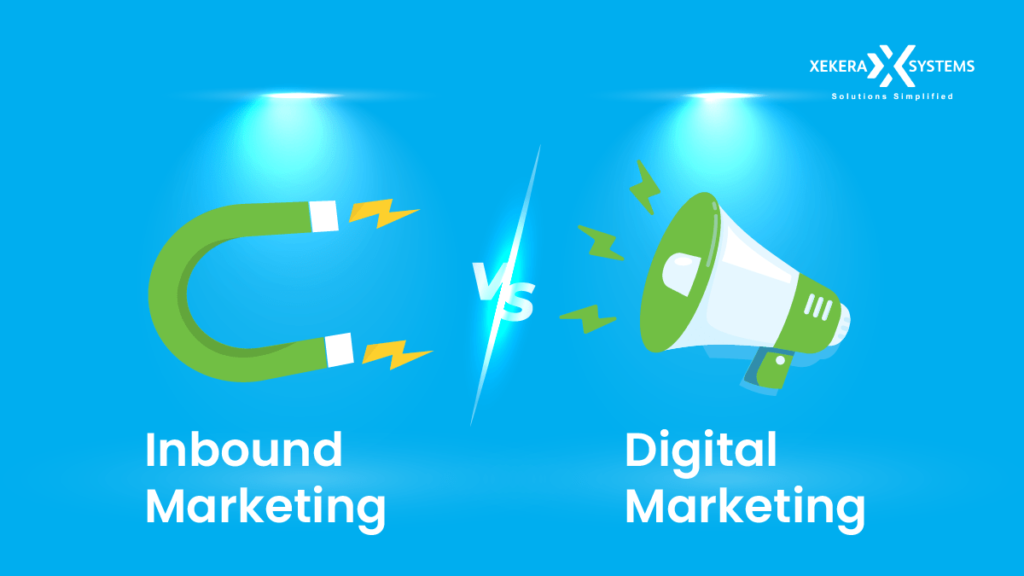
Inbound marketing is the methodology of using digital marketing resources to attract, retain and delight customers online. Digital marketing, on the other hand, is a generic term for all types of online marketing tactics, whether inbound or outbound.
Digital marketing is often compared to inbound marketing, but no distinction is made between ‘inbound’ and ‘outbound’ methods. As a generic term for all marketing that deals with digital communications, inbound marketing is more strategic.
A digital outbound strategy aims to get your marketing message online to as many people as possible, whether relevant or welcome. For example, the flashy advertising banners that appear at the top of many websites try to convey products and promotions to people who aren’t necessarily ready to receive them.
On the other hand, a marketer who employs digital inbound tactics uses her online content to attract target customers to her company’s website by providing them with a useful asset.
One of his simplest and most powerful digital inbound marketing assets is his blog. A blog allows her website to leverage the terms her ideal customers are searching for.
Does Digital Marketing Work For Any Business?
Digital Marketing Works For Any Business In Any Industry. No matter what your business sells, digital marketing involves building buyer personas, identifying your audience’s needs, and creating valuable online content. However, that doesn’t mean that all businesses should implement their digital marketing strategy the same way.
B2B Digital Marketing
If your business is business-to-business (B2B), your digital marketing efforts may be focused on online lead generation with the ultimate goal of reaching salespeople . It’s about getting someone to talk to you. Therefore, the role of your marketing strategy is to attract and convert the highest quality leads for your sellers through your website and supporting digital channels.
Outside of your website, you can choose to focus on business-focused channels such as LinkedIn.
B2C Digital Marketing
For business-to-consumer (B2C) businesses, the goal of any digital marketing effort, depending on the price of the product, is to attract and grow people to your website. There is a possibility. Acquire customers without even talking to a sales rep.
So, rather than a ‘lead’ in the traditional sense, the emphasis is on accelerating the buyer’s journey from the moment someone visits his website to the point of purchase. This often means that product features are higher in the content marketing funnel than his B2B company, which may require the use of a stronger call to action (CTA).
For B2C companies, channels like Instagram and Pinterest are often more valuable than business-focused platforms like LinkedIn.
What type of digital content should you create?
The type of content you create depends on your audience’s needs at different stages of the buyer’s journey. Start creating your buyer personas and identify your audience’s goals and challenges for your business. Essentially, online content is meant to help users achieve their goals and overcome challenges.
Next, you need to think about when that content is most likely to be consumed relative to where you are in the buyer’s journey. This is called content attribution.
The goal of content mapping is to tailor content to consumer characteristics (this is where buyer personas come into play).
How close is this person to shopping (i.e. their life cycle stages).
Need to experiment with content formatting. Here are our recommended options for each stage of the buyer journey:
Cognitive Stages
- Blog Post. Combined with a strong SEO and keyword strategy, it’s perfect for increasing organic traffic.
- infographics. It’s highly shareable, and when others share your content, you’re more likely to be found on social media.
- short videos. These are very shareable, and hosting them on platforms like YouTube can help introduce your brand to new audiences.
Consideration Stage
eBook. They are generally more comprehensive than blog posts or infographics and are great for lead generation. This means that you are more likely to exchange and receive contact information.
Investigative Report. Again, this is quality content that’s great for lead generation
However, industry research reports and new data are often featured in the media and professional journals, so they are also effective at the awareness stage.
Webinars. Webinars are an effective content format for the deliberation phase because they provide richer content than blog posts or short videos because they are a more in-depth, interactive form of video content.
Decision Phase
Case Studies. Having detailed case studies on your website can be an effective form of content for someone ready to make a purchasing decision.
Testimonies. If case studies aren’t a good fit for your business, we also recommend posting short testimonials on your website. If you’re a clothing brand, these could be photos of how other people have styled their shirts and dresses, derived from your brand’s hashtags that people can contribute to.
How to Do Digital Marketing
- Define Your Goals
- Identify Your Target Audience
- Set a Budget for Each Digital Channel
- Find a Balance Between Paid and Free Digital Strategies
- Create Engaging Content
- Digital Assets optimized for mobile devices
- Keyword research performed
- Iterations based on measured analysis
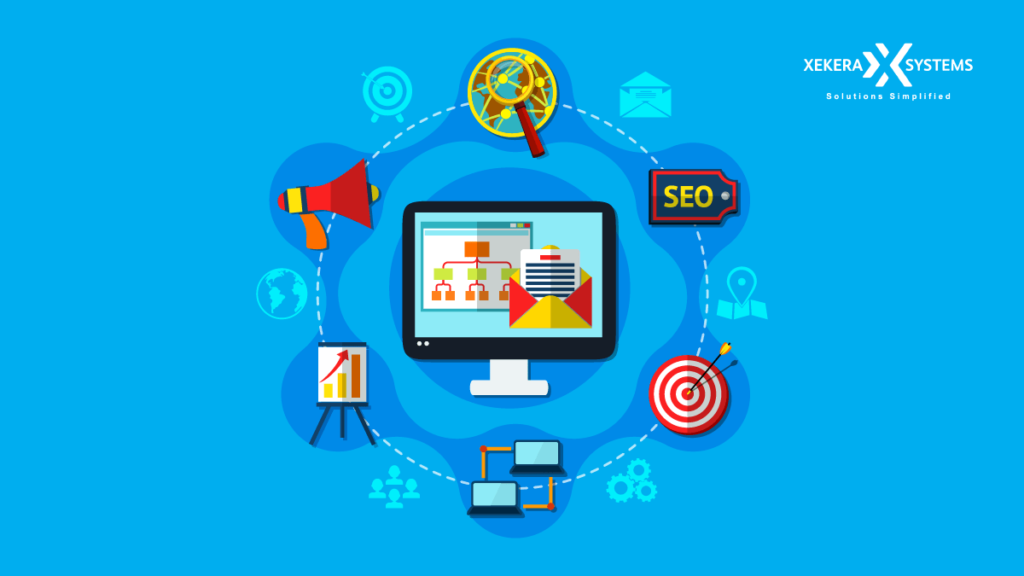
1. Define Your Goals
When you first start digital marketing, it’s important to start by identifying and defining your goals. Because we shape our strategies differently based on these goals. For example, if your goal is to build brand awareness, you should pay more attention to reaching new audiences through social media.
Or maybe you want to increase sales of a particular product. In that case, it is more important to focus on SEO and content optimization to attract potential buyers to her website in the first place.
can also try his PPC campaigns to increase traffic through paid advertising, although sales targets.
Either way, it’s easiest to develop a digital marketing strategy after you’ve identified your company’s key goals.
2. Identify Your Target Audience
We’ve talked about this before, but one of the greatest benefits of digital marketing is the ability to target specific audiences. at first.
Of course, it’s important to note that audiences can vary by product, campaign channel and goals.
For example, most Instagram users are young and prefer fun memes and quick videos, while LinkedIn’s audience is largely made up of older professionals looking for more tactical advice. You may have noticed. Your content needs to change to appeal to these different audiences.
3. Set a budget for each digital channel
If you’re focused on inbound techniques like SEO, social media, and content creation for your existing website, you don’t need a big budget at all. Inbound marketing focuses on creating quality content that your audience wants to consume. Unless you plan to outsource the work, just invest your own time.
You can start hosting your website and creating content on your CMS. If you’re on a tight budget, you can start with WordPress hosted on WP Engine. StudioPress Simple lets you create no-code websites using the Elementor website builder for WordPress.
Dissemination methods such as online advertising and buying mailing lists definitely come at a cost. The cost depends on the type of visibility you need as a result of your ad.
For example, to implement PPC in Google AdWords, bid other businesses in your industry to appear at the top of Google search results for keywords related to your business
Depending on how competitive your keywords are, this can be very affordable or very expensive, so it’s a good idea to also focus on building organic reach.
4. How to Find the Right Balance in a Free Digital Strategy
A truly effective digital marketing strategy probably requires both paid and free aspects.
For example, even if you spent time creating comprehensive buyer personas, identifying your audience’s needs, and creating quality online content to engage and convert your audience, you probably won’t have more than six months In addition, advertising costs are minimal for good results. . .
However, if paid advertising is part of your digital strategy, results can be even faster.
Finally, for long-term and sustainable success, we recommend that you focus on building organic (or “free”) reach using content, SEO, and social media.
If in doubt, try both and repeat the process to see which channel (paid or free) works best for your brand.
5. Create compelling content
Once you know your audience and have a budget, it’s time to create content for the different channels you use. This content includes social media posts, blog posts, PPC ads, sponsored content, and email marketing newsletters.
The purpose of marketing content is, of course, to increase brand awareness and improve lead generation. So the content you create should be interesting and engaging for your audience.
6. Optimize your digital assets for mobile devices
Another key component of digital marketing is mobile marketing. In fact, smartphone use accounts for 69% of the time spent consuming digital media in the US.
Meanwhile, desktop-based digital media consumption is less than half, and the US is not the biggest fan of mobile devices compared to other countries.
This means that optimizing digital ads, websites, social media images and other digital assets for mobile devices is essential. If your business uses a mobile he app that allows users to interact with brands or buy products, then that app also falls under the digital marketing umbrella.
People doing business online from mobile devices want the same positive experiences they have on their desktops. This means implementing a mobile friendly or responsive website design to facilitate user browsing on mobile devices. It also means reducing the length of your lead generation forms to provide a hassle-free experience for people downloading your content on the go. Mobile devices can shrink images and truncate text, so it’s important to always keep mobile users in mind when creating images for social media.
There are many ways to optimize your digital marketing assets for mobile users. When implementing a digital marketing strategy, it’s very important to consider how the experience translates to mobile devices. By making sure this is always at the forefront, you can create digital experiences that work for your audience and deliver the results they expect.
7. Conduct Keyword Research
Digital marketing is all about reaching your target audience through personalized content. This is not possible without effective keyword research.
Conducting keyword research is essential to optimizing your website and content for his SEO and ensuring that people can find your business through search engines.
Additionally, social media keyword research can help you market your products and services on various social channels.
He wants to do keyword research full time and without an SEO strategist. Make a list of high-performing keywords related to your product or service and consider long-tail variations as additional opportunities.
8. Repeat Measured Analytics
Finally, in formulating an effective long-term digital his marketing strategy, it is important for the team to learn how to use analytics.
For example, a few months later, your audience may not find your content as interesting on Instagram, but they will love what you create on Twitter. Sure, this could be an opportunity to rethink your entire Instagram strategy, but it could also be an indication that your audience is choosing a different channel to consume branded content.
Or you notice that your old website isn’t getting as much traffic as it used to. Consider refreshing the page or removing it entirely to ensure your visitors find relevant, up-to-date content that suits their needs.
Digital marketing presents companies with a very flexible opportunity for continued growth, but it’s up to you to take advantage of it.
Ready to try digital marketing. What now?
If you’re already doing digital marketing, chances are you’re reaching at least some of your audience segments online. However, we can definitely think of some areas of the strategy that could use some improvement. I have created a step by step guide.
Let’s take a look at some inspiring digital marketing examples.
Digital Marketing Examples
- Lego’s Rebuild the World Campaign
- Dove Real Beauty Campaign
- Jennifer Lopez’ #InTheMorningChallenge Campaign
- Always’ #LikeAGirl Campaign
1. Lego’s Rebuild the World Campaign
This is a method called a digital marketing campaign. In this campaign, LEGO will address important global issues to connect with its audience.
In today’s world, it is becoming more and more important for companies to discuss global issues and demonstrate alignment with their customers. The main purpose of this campaign is to share your brand’s story and message.
This was a good move for the toy brand as 89% of his customers buy from brands that share their values.
2. Dove’s Reverse Selfie Campaign

As Dove saw how social media was influencing children, especially young girls, he decided to send a message. Invert Her Selfie Her campaign shows the exact opposite, with a teenager preparing to take a selfie and photoshopping her image into her. The goal is to raise awareness about how social media negatively impacts self-esteem.
This is a great way for marketing to see what her content looks like when they have a complete grasp of their audience. A good example to show. Dub knows a real female audience, including many parents, and social she has been able to shed light on the often overlooked impact of the media’s growth.
3. #InTheMorningChallenge by Jennifer Lopez
In this social media campaign, Jennifer Lopez created a dance challenge to promote her new song. In this challenge, fans perform the same dance in pajamas and costumes. The social media campaign was a success as
videos surpassed her 13 million views and her 5,000 posts.
Leveraging social media is a great way to engage your audience and put your brand in direct contact with them.
4. Always’ #DayoftheGirl Campaign
This is another digital campaign focused on emotional marketing. For this campaign, Always asked employees what tips they would give the girls. On International Day of the Girl, an international holiday held each October, the women share their valuable insights in a way that is meant to inspire everyone.
Again, this is not a product-focused campaign, but that’s not the point. The goal of this digital Her campaign was to engage an audience. This message allows them to reach even more people, increase brand awareness, and show audiences that the brand aligns with their values. Embedded:
Everything that connects with your audience Opportunities are opportunities to convert leads or acquire customers.
Digital marketing further enhances these opportunities by enabling you to reach potential buyers across multiple channels. Whether it’s on social media platforms, websites, text messages, or online media, it’s an invaluable way to promote your business, service, or product.
If you are looking for digital marketing services, feel free to contact us online or call us at (408) 982-5851.
